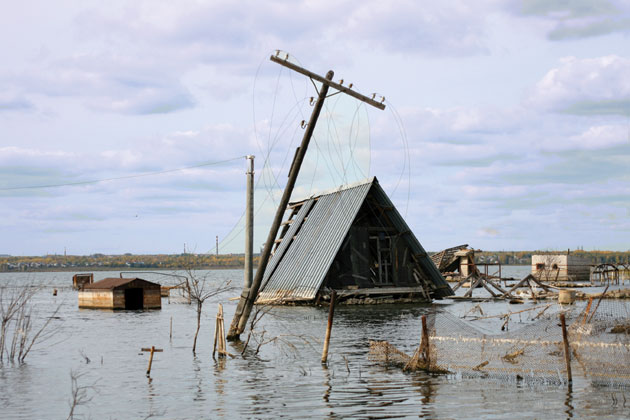
Californians have long been awaiting the "Big One." Perched precariously atop the volatile San Andreas Fault, the state has endured devastating earthquakes and inspired Hollywood blockbusters about the end of the world as we know it. Portrayed as a quake large enough to bring the state to a standstill, the Big One has always loomed ominously, promising damages of up to $200 billion and conjuring images of toppled buildings amid piles of rubble. However, recent studies by the United States Geological Survey (USGS) point to something much worse- -- a giant superstorm with the potential to eclipse any earthquake's destructive forces.
While this superstorm scenario is hypothetical, it is not without precedent. Between 1861 and 1862, storms battered California's Central Valley for 45 days, flooding up to 300 square miles and submerging entire towns. The flooding was so severe that California's capital was temporarily moved from Sacramento to San Francisco, and the governor was forced to row a boat to his inauguration. As the largest storms in California's history, they left lakes in the middle of deserts and livestock swimming in search of dry land.
The catastrophe was also the inspiration for the USGS Multi-Hazard Demonstration Project's (MHDP) latest natural disaster scenario. The goal of the project is to alert residents, policymakers and emergency service personnel to the implications and necessary precautions required for a storm of this magnitude. Geologists studying sediment layers in the San Francisco Bay Area have found compelling evidence that indicates a pattern of extreme storms hitting California about once per century -- meaning that the storm of 1861 was not an anomaly. If history is any indication, we might be overdue for another one.
USGS scientists refer to these superstorms as "ARkstorms," named after atmospheric rivers, or streams of warm, moist air located above the northern Pacific Ocean that, once over California, transform into precipitation. Rising temperatures in the atmosphere have been contributing to the increased formation of atmospheric rivers, which cause greater volatility in weather patterns and increase the likelihood for catastrophic storms. Using computer models, USGS predicts that a modern ARkstorm could produce up to 10 feet of rainfall in California over 40 days. Damage caused by the rain would only be exacerbated by landslides and projected wind speeds of 125 mph.
An ARkstorm would result in unprecedented consequences for California. While the devastation generated by a massive earthquake is largely concentrated within one region, an ARkstorm has the potential to ravage the entire state, causing damages between $300 billion and $1 trillion. One in every four homes would suffer some form of damage, and 1.5 million people would need to be evacuated and relocated, creating a situation similar to the displacement of Hurricane Katrina victims in 2005. Disaster relief would be further impeded by disabled communication systems. Pollution, caused by flooded wastewater treatment plants, can also create safety concerns. The failure of sewer plants, which likely would not return to full operation for months, could bring businesses to a halt and spread disease. In total, economic damages could easily be four or five times greater than those of a high-magnitude earthquake.
The USGS study concludes that California, and the nation as a whole, is unprepared for such a large-scale natural disaster. In previous years, USGS's hypothetical scenarios have successfully called California residents to action; the MHDP's earthquake project, for example, led to the largest emergency preparedness drill in the nation. Dubbed California's Great ShakeOut, the drill taught participants what to do in the event of an earthquake, encouraging them to have disaster supply kits on hand, practice evacuation plans and learn basic first aid. The Great ShakeOut now has seven million participants annually.
Californians can easily apply the lessons learned from these earthquake drills to ARkstorm preparation efforts. The best plan of action for policymakers, on the other hand, is to pay now for mitigation rather than pay later for recovery. Simple steps such as improving infrastructure and shifting emergency operations centers can save millions of dollars -- and many lives -- if a superstorm were to strike.
